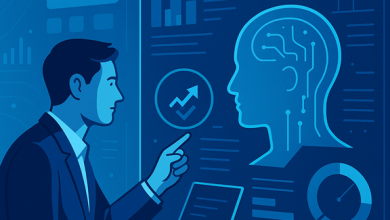
Your AI product will fail.
That’s a sobering statement. But it’s the reality for most companies.
Only 5% of custom enterprise AI tools reach the production stage, according to MIT research.
The reason why is simple: Companies don’t know how to build AI software and may not fully appreciate the internal work required for their businesses to embrace AI from the top down.
What makes it so hard for companies to embrace AI fully? Here are three main culprits:
- The growing disconnect between executives’ expectations and employees’ reality: Too often, executives announce vague plans to become AI-native without considering how it will work or impact their employees, many of whom are already dealing with frustrated customers, overloaded ticket queues, production bugs, etc. Adding an AI overhaul to employees’ already-full plates only results in being spread too thin and faster burnout.
- Employees fear AI: Many teams are still resistant to the technology because they think it will replace them. In fact, 71% of Americans are concerned that AI will put swaths of people out of work permanently. While this fear is understandable, continuing to resist AI when it’s here to stay will only accelerate the process of it replacing you. But it won’t be AI itself that takes your job — it’ll be the workers who know how to use it.
- Executives underestimate the changes true AI adoption and implementation require: Product strategy has to change. Companies must carefully establish expectations related to user interfaces and user experiences for AI. Some executives don’t take this seriously, thinking it’s enough to add AI to legacy systems and assuming that it is less risky than building a product from scratch. However, legacy systems were carefully designed based on structured frameworks, inputs, outputs and algorithms that make them work as intended. AI is fundamentally different — it’s less concrete and can change overnight with a model update. If you try to bolt AI onto your legacy systems, you risk falling behind in the AI revolution.
AI involves a paradigm shift that requires companies to rethink how they build software, manage people and set expectations.
Here’s how to make that shift, align expectations and help people through the change:
Invest in personal learning before setting mandates
Executives who want their employees to be all-in with AI must ensure they are, too.
It’s not possible for an executive to effectively lead their company through this AI revolution without getting their hands dirty and learning what the technology is and isn’t good for, while expecting their teams to do so.
Take the time and effort to understand the technology. This might involve watching YouTube videos on how to build an agent or learning how to code with programs like Cursor. By being hands-on, execs can get a handle on AI’s capabilities and set more realistic expectations for their teams.
Guide, don’t just demand
Employees can’t magically transform their workflows to accommodate AI transformation while also handling day-to-day chaos. Provide them with the direction, resources and structure needed to navigate these changes.
For example, when we decided to go AI-native at GRIN, we rolled out licenses for AI coding tools, opened Slack channels for sharing wins, hosted brown-bag sessions and then set a hard adoption boundary. This gave our team the space to dive into AI and share their experiences as we all tried to wrap our heads around this technology. While some people resisted, the clarity allowed the rest of the team to thrive, and productivity hit levels we’d never seen before.
Start fresh with building products
Simply bolting AI features onto a legacy platform may be a quick fix, but it can leave companies vulnerable to startups that are building AI-native products from the ground up. True impact comes from taking a risk by developing AI-first products.
For example, AI customer service company Intercom has opted to develop a parallel AI product in addition to their core product. Intercom’s Fin AI, its customer support agent, has grown into the centerpiece of its offering without disrupting its legacy system prematurely.
Most AI products don’t fail because the technology isn’t ready; they fail because the companies using them aren’t. AI is not a feature to bolt on; it’s a mindset companies must build in.
Organizations that don’t put in the work to explore the technology, guide employees and reimagine their products will continue to chase hype while falling further behind.
The question isn’t whether AI will change companies. It already is.
The question is whether companies will change enough to survive and thrive with AI.



